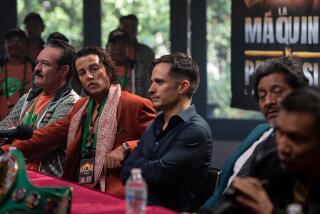âChamacoâ a one-two punch of boxing, bilingualism
As an actor, Martin Sheen has waded hip-deep into the maelstrom of the Vietnam War, led the Confederate Army at Gettysburg and served as his countryâs commander in chief. But he never had to do those things while trying to speak Spanish at the same time.
In making the feature film âChamacoâ (âThe Kidâ), a U.S.-Mexican co-production that opens in theaters this week, Sheen and his fellow cast members faced a dual challenge. First there was the task of pumping fresh blood into a slightly battered genre: the boxing movie.
Then there was the novel imperative of performing in two languages, English and Spanish, while dramatizing the saga of a young Mexican fighter trying to rise above his humble roots and the Mexican capitalâs harsh urban demimonde.
According to its makers, the filmâs bilingual sensibility is no mere narrative gimmick or marketing ploy. With âChamaco,â they say, they didnât only want to tell a compelling story about grit and salvation in a way that would feel authentic. They also wanted to recognize a growing cultural awareness between neighboring countries that donât always understand each other.
âThat was our whole goal, because we believe thatâs the future,â producer Don Franken said in a phone interview this week. âIn the United States so many people ⦠are either from Mexico or speak Spanish, first, second, third generation. And we feel this is a film with a universal theme, boxing, overcoming poverty, overcoming terrible hardships. And then turning your life around and ⦠somehow realizing your dreams.â
Those motifs, and the projectâs wider aspirations, resonated with Sheen. The son of immigrants â his mother was Irish and his father a Spaniard â the actor born Ramón Antonio Gerard Estévez is a devout Roman Catholic known for his advocacy of leftist political causes. He believes that the success of mainstream movies such as Steven Soderberghâs âTrafficâ (2000) prove the viability of telling stories that have traction on both sides of the border.
âThat really swung the door open. That was a big hit, and nobody worried about the language,â Sheen said in an interview during a set visit when âChamacoâ was filming in Mexico City in early December 2007.
In the movie, Sheen plays Frank Irwin, a U.S. doctor who has come to the Mexican capital to work at a poor neighborhood clinic. Among his patients is a scrappy, determined young street fighter, Abner Torres, played by Alex Perea. Events turn complicated when Sheenâs grown son, Jimmy (Kirk Harris), himself a one-time star boxer, arrives unannounced in Mexico City after losing a fight. While Abner yearns for his shot in the ring, Jimmy covets a fresh start in life, and Frank seeks redemption for a botched abortion he performed years ago.
Harris, a former Golden Gloves boxing champion, is also one of the filmâs producers and co-wrote the screenplay with director Miguel Necoechea and co-producer Carl Bessai. Collaborating with Necoechea worked well, in part, Harris said, because âI really knew boxing and he really knew Mexico.â
âI donât speak great Spanish, but I wrote my character that way too,â he added with a laugh.
Harris concedes that a bilingual movie like âChamacoâ flies in the face of Hollywood marketing wisdom. âA couple of the foreign sales people we talked to said, âYou guys are crazy, it needs to be in English,â â he said.
Franken likewise acknowledges that the bilingual strategy is a gamble for his L.A.-based Rogue Arts and its Mexican production partner, Ivania Films. In the 21/2 years since filming was completed, the movieâs release was repeatedly delayed by financing shortfalls, exacerbated by the global recession and the roughly 30% decline in value of the Mexican peso.
Franken estimates that between 40% and 45% of the filmâs $2-million budget came from Mexicoâs FIDECINE (Fondo de Inversión y EstÃmulos al Cine), a federal program that supports domestic movie production. âWe just kept running out of money the whole way along,â said Franken, who has run an L.A. sports marketing and talent agency for more than three decades.
Even so, the filmmakers were able to land some top supporting talent, including cinematographer Guillermo Granillo (âThe Crime of Father Amaroâ), actor Michael Madsen (as Jimmyâs manager-trainer) and Marco Antonio Barrera, the Mexican boxing champion who plays himself in the film.
Not surprisingly, âChamacoâ hews to some familiar boxing-flick tropes: bluntly edited scenes of brutal training sessions, a heart-racing climactic bout and a shapely love interest to engage the adrenalized hero. But it also throws a few unexpected hooks with its cross-border character roster and its candid but non-sensational depiction of Mexico Cityâs rugged social realities.
Franken is planning to shoot a second bilingual movie, a western, later this year in Mexicoâs Durango state, and is working on a third film about the origins of U.S.-Mexican drug trafficking.
Necoechea said that many obstacles remain to more Mexican-U.S. co-productions, including the overwhelming power of Hollywood movies to dominate roughly 95% of all Mexican movie screens. But heâs hopeful the years ahead will bring further âcultural integration between the two countries.â
As fellow members of New World, he said, âI think we share a common vision.â
More to Read
Only good movies
Get the Indie Focus newsletter, Mark Olsen's weekly guide to the world of cinema.
You may occasionally receive promotional content from the Los Angeles Times.











